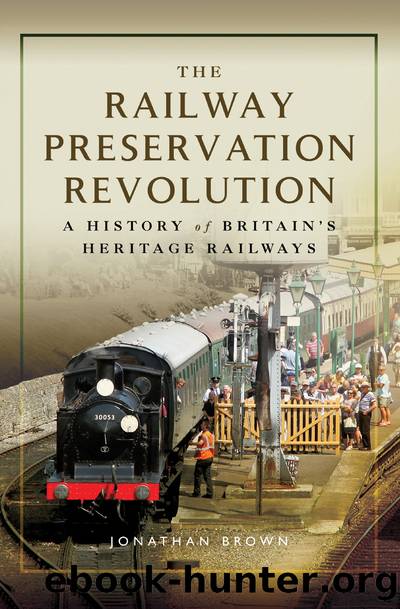The Railway Preservation Revolution by Brown Jonathan;

Author:Brown, Jonathan; [Brown, Jonathan;]
Language: eng
Format: epub
Publisher: Pen & Sword Books
Published: 2017-12-15T00:00:00+00:00
In the 1970s offering shares in the railway operating companies to the public became a popular means of raising large sums for capital projects, such as extending the line, building sheds and repairing viaducts. The North Norfolk Railway Company was the first to do this, issuing a prospectus in November 1969: £16,000 of shares were offered, with the aim of raising £11,700 of that by 31 December. Ambition was exceeded, with 14,000 shares sold by the end of the year. The Llanberis Lake Railway soon followed suit, with plans for a public offer of shares alongside the conventional public appeal for funds.238 The modest ambitions of the North Norfolk were surpassed by subsequent public share offerings. The Severn Valley Railway offered 150,000 shares at £1 each, which raised £56,000 within a few weeks in 1972.239 The Bala Lake Railway Company sold shares through the press in its locality.240 A share issue was a major means of capitalising the Great Central Railway in its early years, £150,000 being raised from its initial issue. Early successes brought some railways back for more. The North Norfolk Railway made another successful offer of shares in 1975, quickly raising £27,000 out of the total of £30,000 of shares. The Severn Valley made a rights issue in 1976 to raise an additional £110,000 to finance covered accommodation for rolling stock.241
In contrast, the Winchester & Alton Railwayâs share issue was an embarrassing failure. It was hugely ambitious, offering 999,993 shares of £1, and with a full-page advertisement in The Daily Telegraph to promote it. The failure to attract more than a tenth of that sum in the required time prompted the Railway Magazine to write that this sent âa clear warning to all railway preservation enterprises ⦠that the climate has changed completely since the boom days when share issues were heavily oversubscribedâ.242 It certainly did: public share offerings became much less popular, but did not disappear by any means. Peak Rail sold shares in 1988. The South Devon Railway made a successful issue of shares to raise the capital to buy the freehold of its line, and in 2008 the Bluebell Railway launched an offer of 1,800,000 shares at £1 to help finance the extension to East Grinstead. Despite the shortfalls from some share issues, this has successfully raised money for capital projects. An alternative to shares sometimes adopted was a public issue of bonds, such as the £175,000 of bearer bonds sold by the Kent & East Sussex Railway in 1987.243
Sales of shares have largely appealed to altruism: many shareholders effectively treated their purchase as a donation to the railway. There is a very limited market for the sale of heritage railway shares â and other types of social enterprise. None of the companies are publicly quoted, although a few brokers will arrange a market. Only the very few commercial enterprises among heritage railways offered any prospect of a dividend, and shares in those companies were rarely placed on public sale. For the rest, a
Download
This site does not store any files on its server. We only index and link to content provided by other sites. Please contact the content providers to delete copyright contents if any and email us, we'll remove relevant links or contents immediately.
| Automotive | Engineering |
| Transportation |
Whiskies Galore by Ian Buxton(41526)
Introduction to Aircraft Design (Cambridge Aerospace Series) by John P. Fielding(32886)
Small Unmanned Fixed-wing Aircraft Design by Andrew J. Keane Andras Sobester James P. Scanlan & András Sóbester & James P. Scanlan(32571)
Craft Beer for the Homebrewer by Michael Agnew(17931)
Turbulence by E. J. Noyes(7698)
The Complete Stick Figure Physics Tutorials by Allen Sarah(7136)
Kaplan MCAT General Chemistry Review by Kaplan(6594)
The Thirst by Nesbo Jo(6433)
Bad Blood by John Carreyrou(6271)
Modelling of Convective Heat and Mass Transfer in Rotating Flows by Igor V. Shevchuk(6220)
Learning SQL by Alan Beaulieu(6033)
Weapons of Math Destruction by Cathy O'Neil(5825)
Man-made Catastrophes and Risk Information Concealment by Dmitry Chernov & Didier Sornette(5645)
Digital Minimalism by Cal Newport;(5389)
Life 3.0: Being Human in the Age of Artificial Intelligence by Tegmark Max(5183)
iGen by Jean M. Twenge(5159)
Secrets of Antigravity Propulsion: Tesla, UFOs, and Classified Aerospace Technology by Ph.D. Paul A. Laviolette(4985)
Design of Trajectory Optimization Approach for Space Maneuver Vehicle Skip Entry Problems by Runqi Chai & Al Savvaris & Antonios Tsourdos & Senchun Chai(4837)
Electronic Devices & Circuits by Jacob Millman & Christos C. Halkias(4745)
